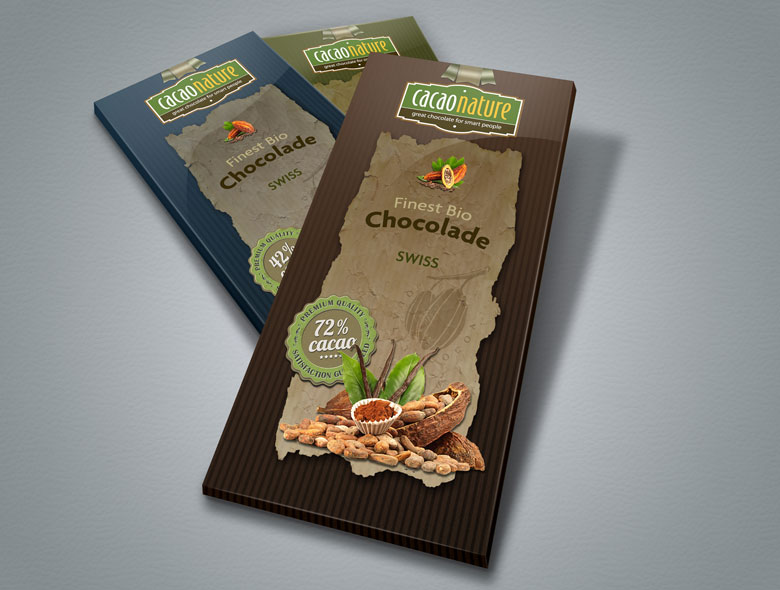Spellbrand Blog
Step By Step Guide To Creating A Winning Brand

If your enterprise is content with a limited customer base, that’s a start. But let’s talk expansion and exploration. To make waves in the retail and service sector, you’ve got to shift from just selling or providing services to becoming a standout Brand.
This isn’t about overnight magic or just a cool logo. It’s about strategic, thoughtful brand building. Dive in with us as we explore this journey, packed with intricate steps and strategies that bring a brand to life.
Why is a Strong Brand Essential for Your Business Success?
A killer brand is your business’s MVP – it’s that crucial. Why? Well, for starters, it gives your business its own unique spot under the sun. It’s not just a name; it’s the personality that helps your customers spot you in a crowd, building trust and recognition.
But there’s more. A rock-solid brand amps up your credibility. Customers dig brands with a solid rep – it’s like a trust magnet. And when your brand screams authenticity and commitment, you’re telling your audience you mean business.
Consistency? That’s your brand’s middle name. Marketing, customer service, your products – it all sings the same tune, building trust and delivering predictably awesome experiences.
And here’s the heart of it: emotional connection. When customers feel that vibe with your brand, they’re yours. They’ll choose you, even if it costs a bit more.
Why?
Because you’re not just selling; you’re resonating.
That’s the power of brand loyalty.
Creating a Brand - Step-by-step Guide

Crafting a Unique Brand Personality that Resonates with Your Audience
Branding isn’t just a logo or a tagline; it’s a journey, just like planning a dream vacation. Think Cyprus, but in the world of branding.
- Deep-Dive Market Research: Utilize both qualitative and quantitative methods. Conduct surveys, focus groups, and in-depth interviews for qualitative insights. For quantitative data, leverage analytics tools to gather information on market trends, customer demographics, and buying patterns. This thorough approach ensures a comprehensive understanding of the market landscape.
- Competitive Analysis Reimagined: Look at competitors’ social media engagement, content themes, and customer interactions. Use tools like Alexa and SimilarWeb for website traffic analysis. This modern approach provides insights into your competitors’ digital strategies and their effectiveness.
- Revolutionize Customer Segmentation: Incorporate big data and machine learning to analyze customer behavior patterns. Use this data to create detailed personas that go beyond basic demographics, incorporating behavioral and psychographic data, such as values, hobbies, and online behavior.
- Brand Differentiation with a Twist: Use your brand’s unique story to connect with customers on an emotional level. Consider your brand’s origins, challenges it has overcome, and its vision for the future. This narrative approach makes your brand more human and relatable.
- Creator archetype Naming: Use creative brainstorming techniques like mind mapping or word association to generate unique names. Consider the international appeal and online searchability of the name. Use tools like Google Trends to analyze potential brand names’ popularity and relevance.
- Brand Storytelling with Substance: Apply storytelling techniques to illustrate your brand’s values and mission. Use customer success stories or behind-the-scenes glimpses into your company to create an engaging narrative. This approach makes your brand more transparent and trustworthy.
- Data-Driven Branding: Implement tools like Google Analytics, social media insights, and customer feedback platforms to continuously monitor your brand’s performance. Use this data to refine your branding strategies and ensure they align with customer needs and market trends.
- Interactive Branding Elements: Create interactive website elements, like personalized product recommendations or interactive brand history timelines. Use gamification techniques in your branding to increase engagement and brand recall.
- Sustainability and Ethics: Communicate your sustainable practices and ethical standards through your marketing materials. Share stories about how your brand is making a positive impact on the environment and society.
- Ongoing Brand Evolution: Regularly revisit and update your brand strategy to ensure it remains relevant. Keep an eye on emerging trends and technologies, and be ready to adapt your brand to stay ahead of the curve.
This is a deep topic and there are tons of other things to do – if you have the inclination, time and budget – to create the right brand. Please read this article which goes in-depth into each of the topics listed above.
RELATED RESOURCES
Check out our positioning strategy service, brand strategy service, messaging strategy service, and pricing strategy service.
WATCH VIDEO

Creating A Ruler archetype Name
After nailing down your positioning and brand strategy, it’s time to crown your brand with a name that resonates. This isn’t just picking a catchy phrase; it’s about crafting an identity.
- Brainstorm with Purpose: Start with brainstorming sessions that are structured yet creative. Use techniques like associative thinking to connect words related to your brand values, target audience, and industry.
- Embrace Uniqueness: A unique name sets you apart in a crowded market. Think beyond conventional names. Experiment with made-up words, blends, or acronyms that are memorable and stand out.
- Cultural Relevance and Sensitivity: Ensure your brand name works globally. It should be easy to pronounce, and culturally sensitive, free from negative connotations in different languages.
- SEO and Online Visibility: Consider the online discoverability of your brand name. It should be SEO-friendly, easy to spell, and available as a domain name and on social media platforms.
- Legal Clearance: Before finalizing, ensure the name is legally available. Conduct a thorough trademark search to avoid future legal complications.
- Feedback Loop: Test the name with your target audience. Collect feedback on how the name is perceived and whether it aligns with your brand personality and values.
- Longevity Over Trends: Choose a name that can stand the test of time. Avoid trendy terms that might become outdated quickly.
- The Sound and Feel: Consider the phonetics of the name. It should sound appealing and evoke the desired emotional response.
- Alignment with Brand Story: Your brand name should be an extension of your brand story. It should reflect the essence and narrative of what your brand stands for.
- Visual Potential: Think about the visual representation of the name in logos and branding materials. It should translate well visually and be adaptable to different design needs.
By diving deep into these aspects, you create a name and a powerful first impression of your brand. A name that sticks tells a story and lays a solid foundation for your brand’s journey.
Here is an article that will help you create the perfect brand name.
RELATED RESOURCES
Check out our brand naming service. Also check out how to create the perfect brand name and 6 questions to ask when creating a brand name.
WATCH VIDEO

Creating A Beautiful Primary Logo Design
After creating the perfect brand name, it is time to create your brand’s visual language. Ideally, you must aim to create the complete brand identity system, but at the very least, start by creating the perfect primary logo design for your brand.
- Originality and Uniqueness: Your logo should be a fresh creation, not a spin-off of existing designs. It needs to stand out in a sea of visuals while encapsulating the essence of your brand.
- Distinct and Meaningful: Every logo element should have a purpose and align with your brand story, from color to shape. It should communicate your brand values and mission at a glance.
- Versatility Across Platforms: A great logo performs well everywhere – on your website, business cards, product packaging, social media, and more. It should be scalable and look good in different sizes and formats.
- Targeted and Focused: The design should resonate with your target audience. It should speak their language, whether professional and sophisticated or fun and quirky.
- Memorable and Timeless: Your logo should be easy to remember and stand the test of time. Avoid overly trendy designs that might look dated in a few years.
- Cohesive Color Scheme: Choose colors that evoke emotions and represent your brand. Color psychology plays a crucial role in how your logo is perceived.
- Appropriate Typography: If your logo includes text, the font should reflect your brand’s character. A tech company might use a sleek, modern font, while a bakery might opt for something more whimsical.
- Balanced Composition: The logo should be aesthetically balanced, with a pleasing arrangement of elements. It should draw the eye in and make a strong visual impact.
- Cultural Sensitivity: Be mindful of cultural symbols and colors to avoid unintended negative associations.
- Feedback and Iteration: Share your logo designs with a focus group that matches your target audience. Gather feedback and be prepared to iterate.
- Professional Design Touch: Consider hiring a professional designer or agency to bring your vision to life. They can add a level of polish and expertise that’s hard to achieve on your own.
- Brand Story Integration: Your logo should be a visual storyteller, subtly conveying your brand’s narrative. It’s not just a symbol but a storyteller.
A logo is more than just an image; it symbolizes your brand’s entire universe. Approach it with the care and creativity it deserves, and you’ll lay a solid foundation for your brand’s visual identity.
RELATED RESOURCES
Here is an awesome article that goes in-depth into how a great logo design is created. Check out our logo design service.
WATCH VIDEO

Designing Your Brand Identity: Brand Marks, Typography, Color Palette, and Visuals
Creating a cohesive brand identity is crucial. It’s about ensuring all visual elements of your brand sing the same tune, forming a symphony that resonates with your audience.
- Secondary Brand Mark: This is your brand’s supporting actor. It complements your primary logo, offering versatility in branding. Ideal for instances where your primary logo might be too dominant, the secondary mark can be a simplified or abstract version, maintaining brand presence without overpowering. Use it on product labels, social media icons, or as a watermark on images.
- Official Brand Pattern: Patterns can be a game-changer. They add depth and texture to your branding, providing a distinctive backdrop to your visual materials. These patterns should echo your brand’s essence, whether organic shapes for a nature-inspired brand or geometric lines for a tech company. Use them on your website’s background, as part of your packaging design, or on promotional items.
- Consistent Typography: Typography is the voice of your brand in written form. Choose fonts that reflect your brand’s personality – professional, whimsical, or avant-garde. Consistency in typography across all your materials – from digital content to print – reinforces brand recognition.
- Color Palette: Colors evoke emotions and convey messages. Your color palette should align with your brand values and appeal to your target audience. Consistent use of colors across all channels helps in creating a recognizable identity.
- Matching Stationery Design: Stationery isn’t just about functionality; it’s a branding tool. Your business cards, letterheads, envelopes, and email signatures should reflect your brand identity. They should be professional, cohesive, and communicate about your brand.
- Visual Hierarchy in Design: Prioritize elements in your design according to their importance. This guides the viewer’s eye and helps in delivering the message effectively. For instance, your brand name and logo in a brochure should be prominent, followed by the key message, and then secondary information.
- Imagery and Photography Style: The style of images used – be it photography or illustrations – should complement your brand personality. Whether high-energy, action shots for a sports brand or serene, minimalist images for a spa, the imagery should be consistent and tell your brand’s story.
- Brand Guidelines Document: Compile a comprehensive brand guideline document. This should include logo usage, color palette, typography, imagery, and more instructions. This ensures consistency across all platforms and materials, irrespective of who works on your brand’s design. For a complete guide on creating effective brand guidelines, see our comprehensive brand guidelines creation guide.
- Adaptable Design for Digital and Print: Ensure your brand identity works well in digital and print formats. This includes responsiveness in digital design and print quality in physical materials.
- Feedback and Evolution: Regularly seek feedback on your brand identity and be open to evolution. Your identity might need tweaking as your brand grows to stay relevant and effective.
Your brand identity is more than just a logo or a color scheme; it’s the visual language communicating your brand’s story, values, and personality. It’s the silent ambassador of your brand.
RELATED RESOURCES
Check out our brand identity service. Also check out our portfolio of awesome brand identities that we created for our clients.
WATCH VIDEO

Designing Effective Print Elements
Print materials are tangible expressions of your brand. They need to be compelling and consistent with your brand identity.
- Brochure Designs: These are storytelling tools. A brochure should not just list services but narrate your brand’s story. Use high-quality images and compelling copy. The layout should be easy to follow, leading the reader through a logical flow.
- Flyers: Ideal for promotions or announcements. They should be eye-catching and succinct, delivering a clear message in a visually appealing way. Use bold headlines and call-to-actions (CTAs).
- Posters: These are your brand’s billboards. Use a mix of impactful visuals and minimal text to grab attention. Ensure the design is aligned with the event or campaign it represents.
- PowerPoint Templates: Custom templates ensure every presentation is on-brand. They should feature your brand’s color scheme, fonts, and logo, providing a consistent backdrop for all corporate presentations.
- Package Designs: Packaging is a direct touchpoint with customers. It should be functional and aesthetically aligned with your brand. Consider sustainability in materials and design.
- Product/Service Data Sheets: These are factual yet need to be engaging. Use clear headings, bullet points, and infographics to make technical information easily digestible.
- Invoices: Often overlooked, invoices can be branded to enhance professionalism. Include your logo and adhere to your brand’s color scheme.
- Sales Letters: They should reflect your brand’s voice. Make them personal, engaging, and direct, addressing the reader’s needs and how your brand can fulfill them.
- Proposals: Your proposals should be persuasive and professional. Use a well-structured layout, branded elements, and clear, concise language.
- White Papers & eBooks: These are tools for thought leadership. The design should facilitate easy reading, with branded headers, footers, and engaging visuals to break up text.
- Company/Business Profiles: These are comprehensive representations of your brand. They should tell your brand’s story, showcase achievements, and include key personnel and contact information.
- Email Templates: Ensure every email sent is on-brand. Templates should include your logo, brand colors, and a standard footer with contact information.
- Consistency Across All Print Materials: Ensure a consistent theme across all print materials. This helps in building a cohesive brand image.
- Quality of Materials: Invest in high-quality printing and materials. This reflects the quality and professionalism of your brand.
- Sustainability Considerations: Where possible, use eco-friendly materials and processes. This benefits the environment and enhances your brand’s image among environmentally conscious consumers.
Each print element is an opportunity to reinforce your brand identity and connect with your audience. They should be designed thoughtfully to convey your brand’s message effectively.
RELATED RESOURCES
Here is an article the goes into each of these print elements in details and how to create the perfect sales material. Check out our print material design service and package design service.
WATCH VIDEO
Marketing Your Brand: Tips and Branding Strategies for Building Brand Awareness
In the digital age, brand marketing is more than just making sales; it’s about creating a resonant presence.
- Holistic Digital Strategy: Develop a comprehensive digital marketing strategy encompassing SEO, content marketing, and social media. Each aspect should work together to create a cohesive online presence.
- Content Marketing: Create valuable content that engages and informs your audience. Blogs, videos, infographics, and podcasts are great ways to showcase expertise and provide value.
- Social Media Engagement: Active social media engagement is crucial. Regular posts, live sessions, and interactive stories can significantly boost visibility and engagement.
- Influencer Collaborations: Partner with influencers who align with your brand values. They can effectively extend your reach to a broader, yet targeted, audience.
- Email Marketing: Use email campaigns to keep in touch with your audience. Personalized emails can drive engagement and keep your brand top-of-mind.
- SEO Optimization: Optimize your website and content for search engines. This improves visibility and helps attract organic traffic.
- Pay-Per-Click Advertising: Invest in PPC campaigns to target specific audiences. This can yield immediate results in terms of traffic and potential conversions.
- Analytics and Adaptation: Regularly analyze your marketing data. Understand what works and adapt strategies accordingly for maximum effectiveness.
- Community Building: Foster a sense of community around your brand. Engage with your audience, respond to comments, and create spaces for discussion and interaction.
- Branding Consistency: Ensure your branding is consistent across all platforms. This creates a unified image that’s easily recognizable.
- Customer Testimonials and Stories: Share customer success stories and testimonials. Authentic customer experiences can be powerful in building trust and credibility.
- Events and Webinars: Host or participate in events and webinars. These can be effective in networking and directly engaging with your audience.
- Partnerships and Collaborations: Form strategic partnerships with other brands or organizations. This can open up new channels and audiences.
- Innovative Campaigns: Launch creative, out-of-the-box marketing campaigns that can go viral and significantly boost your brand awareness.
Each of these strategies contributes to building a robust brand presence, making your brand visible, relatable, and trusted in the digital landscape.
Holistic Digital Strategy for Brand Marketing
- SEO (Search Engine Optimization): Optimize your website and blog content with targeted keywords to improve search rankings. Focus on both on-page SEO (like meta tags, headers, and content quality) and off-page SEO (such as backlinking and social signals). Regularly update your keyword strategy to reflect changing search trends.
- Content Marketing: Develop a content calendar that includes a variety of formats like blogs, videos, infographics, and e-books. The content should educate, engage, and entertain your audience while subtly promoting your brand. Utilize storytelling to make your content more relatable and memorable.
- Social Media Presence: Identify which platforms your target audience frequents and establish a strong presence there. Regularly post engaging content, respond to comments, and participate in relevant conversations. Use social media analytics to understand what content resonates best with your audience.
- Integrated Campaigns: Ensure that your SEO, content marketing, and social media strategies support and enhance each other. For example, use social media to promote your latest blog posts or incorporate SEO keywords into your social media content.
- Data-Driven Decisions: Regularly review analytics from all digital channels. Use this data to refine your strategies, focusing on what works best. This includes understanding user behavior on your website, engagement on social media, and the performance of your content.
- Email Marketing Integration: Use email marketing to complement your digital strategy. Send newsletters, product updates, and personalized offers based on user interests and behaviors.
- User Experience (UX) Optimization: Ensure your website offers an excellent user experience. This includes fast loading times, mobile responsiveness, intuitive navigation, and clear calls to action.
- Online Reputation Management: Actively manage your online reputation by monitoring mentions of your brand, addressing negative feedback promptly, and encouraging satisfied customers to leave positive reviews.
- Influencer Collaboration: Partner with influencers who align with your brand values to reach a wider audience. This can amplify your content and bring credibility to your brand.
- Adaptability: Stay flexible and ready to adapt your strategy to new trends, platform updates, and consumer behavior shifts.
A holistic digital strategy creates a unified narrative across all digital platforms. Each element should stand strong on its own and interweave seamlessly with the others, presenting a consistent and compelling brand story to your audience.
Content Marketing for Brand Awareness and Engagement
- Blogs: Develop a blog strategy covering a range of relevant topics to your audience. Use SEO best practices to improve visibility. Incorporate storytelling, case studies, how-to guides, industry insights, and guest posts from thought leaders.
- Videos: Create engaging video content, including product demos, behind-the-scenes looks, customer testimonials, and educational content. Videos should be optimized for different platforms (like YouTube, Instagram, and TikTok) and include subtitles for accessibility.
- Infographics: Design infographics to simplify complex data or processes. They are shareable and can help explain concepts effectively, making them great for social media.
- Podcasts: Start a podcast series discussing industry trends, interviews with experts, or helpful tips. Podcasts can humanize your brand and build a community of loyal listeners.
- User-Generated Content: Encourage your audience to create content for your brand. This can include testimonials, reviews, or creative uses of your products. Showcase this content on your channels to build community and trust.
- Interactive Content: Include quizzes, polls, or interactive eBooks to engage your audience actively. Interactive content can increase user engagement and time spent on your site.
- Email Newsletters: Create newsletters that provide value beyond just sales promotions. Share industry news, tips, and insights from your blog or video content.
- Webinars and Live Sessions: Host webinars or live Q&A sessions on topics of interest to your audience. This provides an interactive platform for engagement and positions your brand as a Sage archetype.
- Long-Form Content: Produce in-depth guides, whitepapers, or e-books that provide comprehensive information on topics important to your audience. This type of content can be a valuable lead-generation tool.
- Consistent Content Themes: Develop consistent themes or series in your content strategy, like weekly tips, monthly interviews, or regular industry updates. This consistency keeps your audience coming back for more.
- Content Repurposing: Repurpose content across different formats. For example, a blog post can be turned into a video, an infographic, or social media posts.
Effective content marketing is not just about creating content; it’s about crafting relevant, engaging, and valuable experiences that resonate with your audience and reinforce your brand identity.
Maximizing Brand Visibility and Engagement through Social Media
- Regular Posting: Maintain a consistent posting schedule across platforms. Use a content calendar to plan and organize posts in advance. Content should be a mix of promotional, educational, and entertaining to keep the audience engaged.
- Live Sessions: Host regular live sessions on Instagram, Facebook, or YouTube platforms. Use these sessions for product launches, Q&As, behind-the-scenes looks, or to showcase company culture. Live interactions foster a stronger connection with your audience.
- Interactive Stories: Utilize features like polls, questions, and quizzes in your Instagram or Facebook stories. These tools make your content interactive and can provide valuable insights into your audience’s preferences.
- Engaging Visuals: Use high-quality, visually appealing images and videos in your posts. Visual content tends to have higher engagement rates.
- User Engagement: Actively engage with your followers. Respond to comments, messages, and mentions. Show appreciation for user-generated content by sharing it on your platforms.
- Hashtag Strategy: Develop a strategic approach to using hashtags. Use a combination of popular, niche-specific, and branded hashtags to extend your reach.
- Analytics and Insights: Regularly analyze your social media metrics to understand what content works best. Adapt your strategy based on these insights.
- Collaborations and Partnerships: Collaborate with influencers, brands, or industry experts to expand your reach. Choose partners who align with your brand values and have an audience interested in your offerings.
- Contests and Giveaways: Run contests and giveaways to increase engagement and reach. These can effectively attract new followers and keep your current audience engaged.
- Social Listening: Monitor social media for mentions of your brand, competitors, and industry keywords. This can help you understand the sentiment around your brand and identify trends.
- Personalization and Human Touch: Personalize your interactions and show the human side of your brand. People connect with people, not faceless corporations.
- Storytelling: Use social media to tell stories about your brand, customers, or employees. Stories are engaging and can make your brand more relatable.
Active social media engagement is about creating a dynamic and interactive online presence. It’s about broadcasting content and building and nurturing relationships with your audience.
Leveraging Influencer Collaborations for Enhanced Brand Reach
- Identifying the Right Influencers: Start by identifying influencers whose values, audience, and content align with your brand. Look beyond follower count; consider engagement rates, audience demographics, and the authenticity of their content.
- Building Relationships: Cultivate genuine relationships with influencers. Understand their interests and how a partnership can be mutually beneficial.
- Co-Creating Content: Work with influencers to co-create content. This could be in the form of sponsored posts, product reviews, or brand ambassadorships. Ensure the content feels organic and aligns with the influencer’s style and your brand voice.
- Diverse Influencer Tiers: Engage with a mix of influencer tiers – from micro-influencers with niche audiences to celebrities with vast reach. This diversification can broaden your reach and add authenticity.
- Long-Term Partnerships: Consider long-term collaborations for sustained impact rather than one-off campaigns. This builds a more authentic connection with the influencer’s audience.
- Measuring Impact: Set clear KPIs (Key Performance Indicators) to measure the effectiveness of influencer collaborations. Track metrics like engagement rates, traffic to your website, and conversion rates.
- Leveraging Different Platforms: Collaborate on various social media platforms to maximize reach. Different platforms cater to different audience segments.
- Innovative Campaigns: Encourage influencers to be creative and develop innovative ways to showcase your products or services. This can lead to more engaging and unique content.
- Legal and Ethical Transparency: Ensure all collaborations are transparent and compliant with legal guidelines. Influencers should disclose sponsored content to their audience.
- Feedback and Adaptation: Gather feedback from influencers and their audience to improve future campaigns. Be open to adapting your approach based on what works.
When done right, influencer collaborations can be a powerful tool in extending your brand’s reach and building trust with new audiences. It’s about finding the right partners and creating compelling content that resonates with their followers and aligns with your brand values.
Email Marketing: Personalized Communication for Enhanced Engagement
- Segmentation of Email Lists: Categorize your email subscribers based on demographics, behavior, or purchase history. This allows for more targeted and relevant email campaigns.
- Personalization: Go beyond using the recipient’s name. Tailor content based on the recipient’s interests, past interactions, and behavior. Personalization can significantly increase open and click-through rates.
- Regular Newsletters: Send out regular newsletters that include industry news, company updates, tips, or exclusive offers. This keeps your audience informed and engaged with your brand.
- Automated Email Campaigns: Utilize automated email sequences for welcome emails, post-purchase follow-ups, and re-engagement campaigns. Automation ensures timely and consistent communication.
- Mobile Optimization: Ensure your emails are mobile-friendly. With a significant number of users accessing emails on mobile devices, responsive design is crucial.
- Engaging Content: Include content that adds value such as educational articles, videos, or infographics. Make your emails worth opening.
- A/B Testing: Regularly test different elements of your emails (like subject lines, content, and call-to-actions) to see what works best and refine your strategy based on these insights.
- Integration with Other Marketing Channels: Use email marketing as a broader marketing strategy. Include social media links, blog post snippets, or video content in your emails.
- Feedback Loop: Include surveys or feedback forms in your emails. This not only engages your audience but also provides valuable insights.
- Compliance and Unsubscribe Options: Adhere to email marketing regulations like GDPR. Always provide a clear option to unsubscribe, respecting user preferences.
Effective email marketing is about more than just sending out messages; it’s about building relationships, providing value, and creating personalized experiences that resonate with your audience.
Maximizing Visibility through Comprehensive SEO Optimization
- Keyword Research: Conduct thorough research to identify keywords relevant to your business and audience. Focus on a mix of short-tail, long-tail, and local keywords. Utilize tools like Google Keyword Planner for effective research.
- On-Page Optimization: Ensure that each webpage is optimized for relevant keywords. This includes optimizing title tags, meta descriptions, headers, and the content itself. Incorporate keywords naturally and contextually.
- Quality Content Creation: Develop high-quality, informative, and engaging content that addresses your audience’s needs and queries. Google favors content that provides value to users.
- Mobile Optimization: With the increasing use of mobile devices, ensure your website is mobile-friendly. Google prioritizes mobile-optimized sites in its rankings.
- Site Speed Optimization: Work on improving your website’s loading speed. Slow-loading sites negatively impact user experience and search engine rankings. Use tools like Google PageSpeed Insights to identify and fix speed issues.
- Internal Linking Structure: Develop a strong internal linking strategy. This helps search engines understand the structure and hierarchy of your site’s content, and also keeps users engaged longer.
- Backlink Building: Acquire high-quality backlinks from reputable and relevant websites. Backlinks are a crucial factor in how search engines rank websites.
- Local SEO: For businesses with a physical location, local SEO is crucial. Ensure your business is listed on Google My Business and optimize for local keywords.
- Regular Content Updates: Keep your website’s content fresh and updated. Regular updates signal to search engines that your website is relevant and up-to-date.
- Analytics and Monitoring: Regularly monitor your website’s performance using tools like Google Analytics and Google Search Console. Use the insights to refine and adjust your SEO strategies.
- User Experience (UX) Optimization: Focus on creating a seamless and engaging user experience. A well-designed UX can reduce bounce rates and improve the chances of higher rankings.
- Image Optimization: Ensure all images are optimized for faster loading. Use descriptive file names and alt tags for images, incorporating relevant keywords.
Effective SEO is an ongoing process that involves a comprehensive strategy focusing on various aspects of your website and its content. Staying updated with the latest SEO trends and algorithm updates is key to maintaining and improving your search engine rankings.
Enhancing Digital Reach with Targeted PPC Campaigns
- Audience Targeting: Utilize PPC’s robust targeting capabilities to reach specific demographics, interests, locations, and behaviors. Tailor your ads to align with the needs and preferences of your target audience.
- Keyword Selection: Conduct thorough keyword research to identify high-intent keywords relevant to your business. Balance between high-traffic keywords and more specific long-tail keywords to optimize reach and cost-effectiveness.
- Ad Copy and Design: Create compelling ad copy and visuals. The copy should be clear, engaging, and include a strong call-to-action (CTA). Test different ad formats to see what works best with your audience.
- Landing Page Optimization: Direct your PPC traffic to optimized landing pages. These pages should be relevant to the ad, with a clear message and a straightforward path to conversion.
- Budget Management: Carefully manage your PPC budget. Start with a small budget to test the effectiveness of your campaigns and gradually increase based on performance.
- A/B Testing: Regularly test different elements of your PPC campaigns, including ad copy, keywords, and landing pages. Use the insights gained to refine and optimize your strategy.
- Conversion Tracking: Set up conversion tracking to measure the effectiveness of your PPC campaigns. This helps in understanding the return on investment (ROI) and adjusting strategies for better performance.
- Remarketing Campaigns: Implement remarketing strategies to target users who have previously interacted with your website but didn’t convert. Remarketing ads can remind and encourage them to complete the conversion process.
- Staying Updated: Stay abreast of the latest trends and updates in PPC platforms. Platforms like Google Ads and Facebook Ads regularly update their algorithms and features.
- Continuous Learning and Adaptation: PPC is an ever-evolving field. Continuously learning and adapting your strategies based on market trends, platform changes, and performance data is crucial for long-term success.
When executed correctly, PPC advertising can be a powerful tool in your digital marketing arsenal. It allows for precise targeting, immediate results, and measurable ROI, making it an essential component of a holistic digital marketing strategy.
Leveraging Data for Strategic Marketing Adaptation
- Regular Data Analysis: Implement a routine for analyzing marketing data across all channels. Use tools like Google Analytics, social media insights, and CRM software to gather comprehensive data.
- Performance Metrics: Focus on key performance indicators (KPIs) such as website traffic, conversion rates, click-through rates, engagement metrics, and ROI. These metrics provide insight into what’s working and what’s not.
- Customer Behavior Analysis: Track and analyze customer behavior on your website and social media platforms. Understand the customer journey, from initial contact to conversion, to identify potential drop-off points and areas for improvement.
- A/B Testing: Conduct A/B tests on various aspects of your marketing, from email subject lines to landing page designs. This helps in understanding user preferences and optimizing for better results.
- Feedback Integration: Regularly collect and analyze customer feedback. Use surveys, reviews, and direct feedback to gather insights and adapt your strategies to meet customer needs better.
- Competitive Analysis: Keep an eye on your competitors. Analyze their strategies, successes, and failures to gain insights that can inform your strategy adjustments.
- Trend Analysis: Stay updated with industry trends and consumer behavior shifts. Adapt your marketing strategies to align with these trends and maintain relevance.
- ROI Assessment: Regularly evaluate the ROI of different marketing channels and campaigns. Allocate budgets more effectively by investing more in high-performing channels.
- Predictive Analytics: Use predictive analytics to anticipate future trends and customer behaviors. This can inform proactive strategy adjustments.
- Cross-channel Analysis: Look at your marketing efforts holistically. Understand how different channels complement each other and contribute to overall goals.
- Learning and Evolving: Adopt a culture of continuous learning and evolution. Encourage your team to stay curious, experiment, and learn from successes and failures.
You can continually refine your marketing strategies for maximum effectiveness and efficiency by effectively analyzing and adapting based on data. This data-driven approach ensures that your marketing efforts align with your business goals and evolving market dynamics.
Cultivating a Vibrant Brand Community
- Interactive Platforms: Create and maintain platforms where your audience can interact with you and each other. This could be social media groups, forums on your website, or community apps.
- Engagement and Response: Actively engage in conversations with your community. Respond to comments, messages, and posts, showing that you value their input and are listening.
- User-Generated Content: Encourage your community to create and share content related to your brand. Feature this content on your platforms to show appreciation and foster a sense of belonging.
- Regular Updates and Insider Information: Share exclusive news, behind-the-scenes content, or sneak peeks with your community. This makes members feel valued and part of an exclusive group.
- Community Events: Host online or offline events like webinars, meetups, or workshops. These events can strengthen the community bond and increase engagement with the brand.
- Community-Driven Initiatives: Involve your community in certain business decisions or initiatives, like product development or charity events. This can increase their investment in the brand.
- Recognition and Rewards: Recognize active community members with shoutouts, rewards, or opportunities to contribute to the brand in more significant ways.
- Feedback and Co-Creation: Use your community as a sounding board for feedback and ideas. This can lead to valuable insights and innovations for your brand.
- Moderation and Guidelines: Ensure that your community spaces have clear guidelines and are moderated to maintain a positive and respectful environment.
- Building Relationships: Look at community building as an opportunity to build long-term relationships rather than just a marketing tool.
Community building is about creating an environment where your audience feels heard, valued, and connected to your brand and each other. This fosters loyalty and can turn customers into brand ambassadors.
Maintaining a Cohesive Brand Image Across All Channels
- Unified Visual Elements: Your logo, color scheme, typography, and imagery should be consistent across all platforms. This visual consistency helps reinforce brand recognition.
- Consistent Brand Voice: Whether it’s on social media, your website, or in print materials, the tone and style of your communication should reflect your brand’s personality consistently.
- Brand Guidelines: Develop comprehensive brand guidelines that detail how all aspects of your brand should be presented. Ensure that everyone in your organization and external partners understand and adhere to these guidelines. Our complete guide to creating brand guidelines covers everything you need to know, from essential sections to implementation strategies.
- Cross-Platform Integration: Make sure your branding is seamlessly integrated across digital and offline platforms – from your website and social media to packaging and advertising.
- Regular Audits: Regularly audit your brand’s representation across all channels. This can help identify any inconsistencies and rectify them.
- Employee Training: Train your employees on the importance of brand consistency. They should understand how to represent the brand correctly in their roles.
- Feedback Mechanisms: Implement a system for customer and employee feedback and suggestions about brand consistency.
- Adaptability Within Consistency: While maintaining consistency, be adaptable to how your brand is presented across different platforms and contexts.
Brand consistency is key to building trust and recognition with your audience. It’s not just about looks; it’s about creating a consistent experience that resonates with your audience no matter where they encounter your brand.
Leveraging Customer Experiences to Enhance Brand Trust and Credibility
- Collecting Testimonials: Actively request testimonials from satisfied customers. Consider automated emails post-purchase or direct requests following positive service interactions.
- Storytelling in Testimonials: Encourage customers to tell their stories in a way that highlights their journey and experience with your brand. This adds a personal and relatable aspect to the testimonials.
- Diverse Formats: Use various formats for testimonials – written, video, or even audio clips. Video testimonials can be particularly engaging, showcasing real people and their genuine reactions.
- Case Studies: Develop in-depth case studies for more detailed testimonials. Illustrate how your product or service has solved a problem or improved a customer’s life or business.
- Featuring Testimonials: Prominently feature testimonials on your website, social media, and marketing materials. Create a dedicated section on your website for customer stories.
- Regular Updates: Continuously update your testimonials to keep them fresh and relevant. Showcasing recent stories can be more convincing.
- Leveraging Social Proof: Use testimonials as social proof in your marketing campaigns. Seeing others’ positive experiences can significantly influence potential customers.
- Incorporate in Sales Process: Use testimonials in your sales pitches and presentations to build trust and credibility.
- Respond to Testimonials: Engage with customers who leave testimonials. Thank them publicly to show appreciation and encourage others to share their experiences.
- Authenticity is Key: Ensure that all testimonials represent real customer opinions. Authenticity is crucial for credibility.
Customer testimonials and stories are powerful tools in building trust and showcasing the real-life value of your products or services. They provide prospective customers with relatable proof of your brand’s impact, adding depth and authenticity to your brand narrative.
Maximizing Engagement and Networking through Events and Webinars
- Thematic Events and Webinars: Organize events and webinars around relevant themes that resonate with your target audience. Ensure these themes align with your brand values and offerings.
- Interactive Sessions: Incorporate interactive elements such as Q&A sessions, live polls, and breakout rooms to increase engagement and participation.
- Expert Speakers and Panelists: Invite industry experts, influencers, or thought leaders to speak at your events or webinars. This can enhance the value and credibility of your event.
- Cross-Promotion and Partnerships: Collaborate with other brands or organizations to co-host events. This can broaden your audience’s reach and add diverse perspectives.
- Pre-Event Marketing: Utilize email marketing, social media, and other digital platforms to promote your events. Create a buzz with countdowns, teasers, and sneak peeks.
- Post-Event Engagement: After the event, follow up with attendees through emails with key takeaways, additional resources, or a survey for feedback.
- Repurposing Content: Record your events and webinars and repurpose the content. You can create blog posts, social media content, or even short clips to share insights from the event.
- Networking Opportunities: Provide networking opportunities for attendees, such as virtual networking rooms or post-event mixers at physical events.
- Accessibility: Ensure your events and webinars are accessible to a diverse audience, including considerations for different time zones and providing captions for the hearing impaired.
- Measuring Success: Use metrics like attendance rates, engagement levels, and post-event feedback to measure the success of your events and learn for future improvements.
Events and webinars are powerful tools for building relationships, establishing thought leadership, and engaging directly with your target audience. They offer a platform for interactive learning, networking, and brand promotion.
Strategically Leveraging Partnerships and Collaborations for Brand Growth
- Identifying Synergistic Partners: Look for brands or organizations that complement your brand and share similar values. A synergistic partner can enhance your offerings and appeal to your audience.
- Co-Branding Opportunities: Engage in co-branding ventures where both brands can benefit from shared marketing efforts, such as joint products or services.
- Cross-Promotion: Utilize each other’s marketing channels for cross-promotion. This can include social media shoutouts, co-authored content, or shared ad space.
- Event Collaborations: Partner on events like webinars, workshops, or conferences. This can enhance the scale and reach of the event.
- Access to New Markets: Collaborations can open doors to new markets and customer bases that may have been difficult to reach independently.
- Joint Research and Development: Collaborate on research and development to innovate new products or services. This can lead to groundbreaking innovations and shared intellectual property.
- Resource Sharing: Share resources like technology, market data, or expertise. This can be particularly beneficial for smaller businesses or startups.
- Community Projects and CSR: Partner on community projects or corporate social responsibility (CSR) initiatives. This not only benefits society but also enhances brand image and customer perception.
- Mutual Learning and Growth: Use partnerships to learn from each other’s experiences and business practices.
- Long-Term Strategic Alliances: Build long-term alliances that go beyond one-off projects. This can lead to sustained growth and success.
Strategic partnerships and collaborations can be a powerful way to expand your brand’s reach, access new resources, and innovate. They provide opportunities for mutual growth and can open up exciting new avenues for both brands involved.
Igniting Brand Growth with Creative, Viral Marketing Campaigns
- Leverage Storytelling: Create campaigns that tell a compelling story, connecting emotionally with your audience. Stories have a higher potential to go viral due to their relatability and shareability.
- Utilize Emerging Technologies: Incorporate AR/VR, AI, or interactive technologies to create unique, immersive experiences.
- Social Media Challenges and Contests: Design challenges or contests that encourage user participation and sharing, leveraging the power of social media networks for broader reach.
- Partnerships with Influencers: Collaborate with influencers for campaign promotion. Their creative take on your campaign can appeal to a broader audience.
- Data-Driven Creativity: Use consumer data and insights to tailor your campaigns to specific interests and trends.
- Interactive and Gamified Elements: Integrate interactive or gamified elements in your campaigns, which can increase engagement and make them more memorable.
- Unique Hashtags: Create unique, catchy hashtags for your campaigns, making them easily identifiable and shareable.
- Real-Time Marketing: Capitalize on current events or trends in real-time to create relevant and topical marketing content.
- Customer-Centric Campaigns: Design campaigns that put your customers at the center, such as featuring real customer stories or co-creating content with the audience.
- Bold and Unconventional Approaches: Don’t be afraid to try bold and unconventional ideas. Sometimes, the most outlandish campaigns capture the public’s imagination.
Innovative campaigns are about thinking outside the box and creating something truly memorable. They should capture attention and encapsulate your brand’s essence in a way that resonates with your audience and encourages sharing.

Domain Name Registration
Before you even think about designing a website, you need to register a domain address. This is another exercise that will frustrate you as you realize that almost all the brand names you think of will have already been registered as domain addresses.
So, this step ties back to Step #2 and should be done in tandem. You will also realize why it is a good idea to pick a unique, invented, or made-up brand name, as that will make it easy to get domain addresses, social media handles etc.
Strategic Approach to Domain Name Registration for Brand Success
- Early Registration: Register the domain name as soon as you finalize your brand name. This avoids the risk of losing the ideal domain to someone else.
- Brand Alignment: Choose a domain that is precisely matched or closely related to your brand name. This consistency is key for brand recognition and memorability.
- Top-Level Domains (TLDs): Preferably choose a .com domain as it is the most recognized TLD. However, depending on your industry, don’t shy away from other TLDs like .net, .org, or even more specific ones like .tech or .fashion.
- Simplicity and Clarity: Keep your domain name short and easy to spell and remember. Avoid complex spellings and long names that could be prone to typos.
- Avoid Hyphens and Numbers: Domain names with hyphens and numbers can be confusing and are harder to communicate verbally.
- Future-Proofing: Consider the longevity and adaptability of your domain name. It should be flexible enough to encompass potential future expansions of your brand.
- Checking Availability on Social Media: Ensure that the domain name (or a close variation) is available on major social media platforms. This consistency across the web strengthens your online presence.
- Domain Privacy Protection: Invest in domain privacy protection to keep your registration details private and protect against spam or identity theft.
- SEO Considerations: While exact-match domains are no longer a necessity for SEO, having relevant keywords in your domain can still be beneficial.
- Renewal Management: Set your domain to auto-renew to avoid losing it accidentally, and keep your registration details current.
Choosing the right domain name is a critical step in establishing your online brand identity. It requires balancing brand alignment, simplicity, memorability, and future growth considerations.
RELATED RESOURCES
A few good domain name registrars are Godaddy, Hover, Dynadot, Google Domains, Namecheap and more.
WATCH VIDEO

Creating A Stunning Website Design
The next major investment you can make into your brand is your custom website design. This is one asset you do not want to go cheap on. Your website is your best tool in building brand awareness, trust and ultimately increasing revenues. Even if you are a brick-and-mortar business, your website is a powerful touchpoint that a lot of your target audience would reach out to before they do business with you.
At the very least, your website should have a CMS (content management system) and a BLOG.
- A CMS enables you to edit the pages, create new pages, upload images and videos, etc to your website. They get automatically published live without running to a website designer each time you need to make a change. This will save you a lot of money in the long run.
- A BLOG is a news section of your website that enables you to post fresh new content on your website regularly, increasing your authority as well as your Google rankings and traffic, as Google loves websites with fresh content.
When getting your website design, make sure these 7 deadly website design sins are not being committed:
- The website should not be slow
- A dated design with too much text
- The website should not be ugly on the mobile phone
- Do not use images that are low quality and ugly
- The website should have great branding including a logo design and corporate color palette
- The website should use fonts judiciously
- You should not use a free website builder for your business website
- The website should be SEO friendly
The bottom line is that going cheap on your website design will have dire consequences on your brand image and revenue. Not investing in a professional website will have opportunity costs.
Elevating Your Brand with a Professionally Designed Website
- Invest in High-Quality Design: Your website is often the first impression of your brand. Invest in a professional, modern, and aesthetically pleasing design that aligns with your brand identity.
- User Experience (UX) Design: Prioritize the user experience. A well-designed website should be intuitive, easy to navigate, and accessible to all users, including those with disabilities.
- Responsive Design: Ensure your website design is responsive across all devices, providing a seamless experience on desktop, tablet, or mobile.
- Content Management System (CMS): Utilize a robust CMS that allows you to easily manage and update website content, offering flexibility and control over your site.
- Regularly Updated Blog: Maintain a blog with regular, fresh content. This boosts SEO and establishes your brand as an authority in your field.
- Optimized Page Load Speed: Ensure your website loads quickly to reduce bounce rates. Use tools like Google PageSpeed Insights to optimize loading times.
- Visual Appeal and Branding: Incorporate high-quality, relevant images and a color scheme that reflects your brand. Consistent use of your logo and brand colors enhances brand recognition.
- Strategic Use of Fonts: Choose readable fonts that reflect your brand’s personality. Avoid using too many different fonts, which can clutter and confuse the design.
- Avoid Free Website Builders for Professional Sites: While free website builders can be tempting, they often lack customization and professionalism. Investing in a custom design sets you apart from competitors.
- SEO-Optimized Design: Design your website with SEO in mind to improve visibility on search engines. This includes optimizing metadata, using alt tags for images, and structuring content for readability.
- Call-to-Action (CTA) Placement: Strategically place CTAs to guide visitors towards taking desired actions, like contacting you, signing up for a newsletter, or purchasing.
- Analytics Integration: Incorporate tools like Google Analytics to track visitor behavior, which provides insights for ongoing optimization.
- Security Measures: Implement security protocols like SSL certificates to protect your site and users’ data.
- Social Media Integration: Include social media buttons to encourage users to follow and share content on social platforms.
- Test and Iterate: Continuously test different aspects of your website and make improvements based on user feedback and behavior.
Investing in a professional website design is crucial for establishing credibility, enhancing user experience, and building a strong online presence. It’s a pivotal tool in your digital marketing arsenal, directly impacting brand perception and business growth.
RELATED RESOURCES
For more details on the proper way to brand, please read this article on the 10 Commandments of Brand Building. Check out our website design service.
WATCH VIDEO

Empowering Your Social Media Channels
After the website has been designed and hosted, or even before the website and after the brand identity, you would need to create your social media platform, design the branding for them and optimize them to help you with your social media marketing.
Depending on your market segment, you should choose 2-3 main social media channels to focus on. For example, if you are in the clothing, apparel and fashion business then you should focus on Instagram, Facebook and Youtube in that order. If you are a law firm or a financial consultant, then you should focus on LinkedIn, Twitter and Youtube. And so on.
I have written in-depth marketing guides on several social media channels including Facebook, Twitter, Instagram, Pinterest, Youtube, etc.
Make sure to have a consistent social media presence through social media posts. Your social media posts can be any piece of content as long as it is relevant to your brand and resonates with the emotions and expectations of your potential customers.
RELATED RESOURCES
Check out a very useful article I have written on the Ultimate Guide To Social Media Marketing as well as on how to Create a Social Media Strategy. Also check out our social media management services.
WATCH VIDEO

Step 10: Innovating Your Brand and Staying Ahead of the Curve
Innovating your brand and staying ahead of the curve in today’s digital landscape involves a strategic blend of SEO (Search Engine Optimization) and SEM (Search Engine Marketing). These digital marketing strategies are pivotal in driving traffic to your website through search engines, a critical aspect of any online business presence.
SEO focuses on enhancing your website’s visibility in organic search results. It’s an investment of time and effort in optimizing website content with targeted keywords, improving site structure, and building a network of backlinks. The beauty of SEO lies in its cost-effectiveness, as it primarily leverages organic search traffic, which, although time-consuming, tends to be more sustainable and credible in the long run.
On the other hand, SEM encompasses paid advertising, notably through platforms like Google AdWords. This approach allows for immediate visibility in search engine results but requires a financial investment. Each click on your ad incurs costs, making SEM a more direct yet potentially costly strategy. It’s particularly effective for quick visibility boosts or targeting highly competitive keywords.
However, the intricacies of managing a successful SEM campaign, with considerations like bidding strategies and ad optimization, often necessitate the expertise of a PPC (pay-per-click) agency. While this adds to the cost, their experience can significantly enhance the efficiency and effectiveness of your campaigns, thereby potentially improving ROI.
Balancing SEO and SEM is key for modern businesses. While SEO builds a strong, organic foundation for your online presence, SEM offers the agility to capitalize on market opportunities quickly. Together, they form a dynamic duo that can significantly increase targeted traffic to your website, vital for staying competitive and relevant in an ever-evolving digital marketplace.
RELATED RESOURCES
Check out our SEO services as well as our SEM services. Also check out our search engine boost campaign service.
WATCH VIDEO
The Takeaway
The journey to elevate a business into a brand with a unique and powerful identity is intricate and challenging. At SpellBrand, we understand that the essence of your brand is deeply rooted in your vision and values. Our approach is centered around you, the visionary behind the brand. Our team of seasoned professionals collaborates closely with clients, ensuring that the brand’s development is a true reflection of their aspirations.
We strive to create a brand presence that is effective and impactful and resonates with the core identity you envision. This collaborative, client-focused approach sets the stage for a brand that stands out, truly representing the unique essence of your business.
Reach out to us, and let’s embark on this transformative journey to bring your brand vision to life.
Frequently asked questions
How do I develop a brand voice and messaging strategy?
To develop a brand voice and brand messaging strategy, define your brand’s personality, values, and target audience. Then, craft a consistent tone of voice and message that resonates with your audience and aligns with your brand’s overall identity.
What are some effective strategies for building brand awareness?
Building brand awareness is crucial for any business to flourish in today’s competitive market. Here are some effective strategies that can be employed to develop and improve brand awareness:
- Social Media Marketing: Social media platforms like Facebook, Instagram, Twitter, LinkedIn, and others provide a vast audience base for businesses to connect with. Regular posts, engaging stories, interactive polls, or live sessions can significantly boost brand visibility. Additionally, utilizing targeted ads on these platforms can help reach potential customers more effectively.
- Content Marketing: This involves creating and sharing valuable, relevant content that resonates with your target audience. Blog posts, e-books, white papers, infographics, webinars, podcasts, and videos are some types of content that can be used. The goal is to educate, entertain, or inspire, building a relationship with your audience and positioning your brand as an industry expert.
- Influencer Marketing: Collaborating with influencers who have a substantial following in your industry can be an effective way to boost brand awareness. Influencers can promote your products or services to their audience, giving your brand a credible endorsement and exposure to a broader customer base.
- Event Sponsorships: Sponsoring events relevant to your industry can help increase brand visibility and reputation. It allows your brand to interact directly with potential customers and associates your brand with positive experiences or causes.
- Public Relations: PR strategies can involve sending press releases to media outlets about noteworthy company news, participating in community events, or managing potential crises. Effective PR can enhance your brand’s reputation and increase its visibility in the public eye.
- Search Engine Optimization (SEO): SEO is a powerful tool to increase brand awareness. Optimizing your website and content for search engines can improve your site’s ranking, making it easier for potential customers to find you online.
Remember, the most effective strategies depend on your business, industry, and target audience. Understanding your audience’s preferences and habits is essential to determine the most effective strategies.
How can I maintain brand consistency and continuity across all brand touchpoints?
Maintaining brand consistency and continuity across all touchpoints is crucial in establishing a strong and recognizable brand. Here are some strategies you can employ:
- Establish Comprehensive Brand Guidelines: A brand guideline is a document that outlines your brand’s visual and verbal elements. This includes your logo usage, color palette, typography, imagery style, and key messaging. It also outlines the tone of voice that should be used in all communications. These guidelines ensure that anyone working on your brand—in-house team members or external partners—understands its core essence and projects it consistently. For detailed guidance on creating comprehensive brand guidelines, check out our complete brand guidelines creation guide.
- Website Consistency: Your website is often the first point of contact for customers, so it’s essential to maintain consistency here. The design, content, and user experience should align with your brand guidelines. This includes consistent use of colors, fonts, tone of voice, and imagery.
- Social Media Consistency: Ensure your brand voice and visual elements are consistent across all social media platforms. This doesn’t mean every post has to look identical, but they should look like they belong to the same family. The brand personality should be evident in all interactions, from post captions to responses to comments.
- Packaging and Physical Branding: If your business involves physical products or storefronts, ensure that your packaging, signage, interior design, uniforms, etc., adhere to your brand guidelines. This helps to create a cohesive brand experience in the physical world.
- Advertising and Marketing Collateral: All your marketing materials, both offline and online, should align with your brand guidelines. This includes advertisements, brochures, email campaigns, and promotional merchandise.
- Customer Service: Your brand should even extend to how your customer service team interacts with customers. The tone of voice and language should match your brand personality, whether it’s friendly, formal, playful, or serious.
- Regular Audits: Conduct regular audits of all your brand touchpoints to ensure they align with your brand guidelines. If any inconsistencies are found, take steps to correct them immediately.
Maintaining brand consistency and continuity helps to build customer trust and brand recognition. It ensures that regardless of how or where customers interact with your brand, they have a consistent and predictable experience that reinforces your brand identity.
How do I measure the success of my brand?
Measuring the success of your brand requires a mix of qualitative and quantitative analysis. Here are several methods to help you gauge the effectiveness of your brand:
- Brand Awareness: This refers to the extent to which consumers are familiar with your brand. You can measure brand awareness through surveys asking consumers if they recognize your brand or through analyzing website traffic and social media metrics like reach and impressions.
- Customer Loyalty: Loyal customers are a strong indicator of brand success. Metrics like repeat purchase rate, customer retention rate, and Net Promoter Score (NPS) can help measure customer loyalty. NPS, in particular, can tell you how likely your customers are to recommend your brand to others.
- Brand Equity: This is the perceived value of your brand in the minds of consumers. High brand equity can lead to higher sales and profitability. Surveys can help measure brand equity by asking consumers about their perceptions and associations with your brand.
- Market Share: This refers to the percentage of total sales in your industry made by your company. An increase in market share can indicate growing brand success. This can be calculated by dividing your company’s total sales by the industry’s total sales.
- Customer Surveys: Direct customer feedback can provide valuable insights into your brand’s performance. You can ask customers about their perceptions of your brand, satisfaction with your products or services, and the likelihood of recommending your brand to others.
- Focus Groups: These can provide in-depth insights into consumer perceptions of your brand. Participants can give feedback on various aspects of your brand, such as your products, marketing, customer service, and more.
- Social Media Listening: This involves monitoring social media platforms for mentions of your brand, competitors, products, and more. It can provide insights into consumer sentiment about your brand and highlight areas for improvement.
- Sales Revenue: Ultimately, strong brands should drive sales. Track your revenue growth over time to see if your branding efforts translate into financial success.
Remember, the key to successfully measuring your brand’s success is consistency. Regularly tracking these metrics over time can help you understand trends, identify areas for improvement, and make data-driven decisions to improve your brand strategy.
What are some common branding mistakes to avoid?
Navigating the process of branding or rebranding can be complex, and it’s easy to make mistakes along the way. Here are some common branding pitfalls to avoid:
- Lack of Research: Failing to conduct comprehensive market and audience research can result in a brand that doesn’t resonate with its target audience or stand out from its competitors. Research your audience’s needs, preferences, behaviors, and competitive landscape before defining your brand.
- Inconsistent Branding: Inconsistency in your visual identity or messaging across different platforms and touchpoints can confuse customers and dilute your brand image. Ensure that your brand guidelines are clear and followed consistently in all communications.
- Ignoring Brand Values: Your brand values should guide every decision you make. Ignoring these values or acting in a way that contradicts them can damage your reputation and customer trust.
- Neglecting to Evolve: Brands should be dynamic and evolve with changing customer needs, market trends, and business growth. Failing to update or refresh your brand over time can make it seem outdated or irrelevant.
- Poor Quality Visuals: The visuals you use to represent your brand, and poor quality visuals can give the impression of a low-quality brand. Invest in high-quality design for your logo, website, and other branded materials.
- Overcomplicating Things: Overly complicated logos, jargon-filled messaging, or a complex brand story can make it difficult for customers to understand and connect with your brand. Keep things simple, clear, and customer-focused.
- Ignoring Feedback: Customer feedback is crucial in understanding how your brand is perceived and identifying areas for improvement. Ignoring this feedback can lead to a brand that fails to meet customer needs or expectations.
- Promising More Than You Can Deliver: While it’s important to showcase the best of what your brand offers, promising more than you can deliver can lead to disappointed customers and damage your brand reputation. Be honest and realistic in your branding.
- Lack of Differentiation: If your brand looks and sounds like every other brand in your industry, it will be hard for customers to remember or choose you. Find a unique selling proposition (USP) and ensure it’s reflected in your branding.
By avoiding these common mistakes, you can build a stronger, more effective brand that resonates with your audience, stands out from the competition, and drives business growth.
How can I differentiate my brand from competitors?
Differentiating your brand from competitors is crucial in today’s crowded marketplace. Here are some strategies to help your brand stand out:
- Unique Selling Proposition (USP): Identify what sets your product or service apart from your competitors. This could be anything from superior quality, innovative features, or exceptional customer service. Communicate your USP clearly in all your branding and marketing materials.
- Brand Story: Share the unique story behind your brand. This could include the inspiration for starting your business, the challenges you’ve overcome, or the mission that drives you. A compelling brand story can create an emotional connection with customers and set your brand apart.
- Visual Identity: A unique and consistent visual identity can help your brand stand out. This includes your logo, color palette, typography, and imagery. Consider working with a professional designer to create a visual identity that reflects your brand personality and appeals to your target audience.
- Brand Voice: Your brand voice is the unique style and tone of your written and spoken communication. It should reflect your brand personality and resonate with your target audience. A distinct brand voice can set your brand apart from competitors.
- Customer Experience: Providing an exceptional customer experience can differentiate your brand. This includes all interactions customers have with your brand, from browsing your website to making a purchase, to customer service. Focus on making each interaction as smooth and enjoyable as possible.
- Innovation: Continually innovating your products, services, or processes can set your brand apart. This could involve using the latest technology, developing new product features, or finding ways to deliver your service more efficiently.
- Social Responsibility: Many consumers today prefer socially and environmentally responsible brands. You could differentiate your brand by adopting sustainable practices, supporting local communities, or donating to causes that align with your brand values.
- Personalization: Personalized marketing and services can make customers feel valued and appreciated, helping to set your brand apart. This could involve personalized emails, product recommendations, or customer service.
Remember, the key to successful differentiation is understanding your target audience and what they value most. By focusing on these areas, you can create a brand that truly stands out from the competition.
How do I adapt my brand over time to stay relevant?
As markets evolve and consumer preferences change, brands must adapt and stay relevant. Here are some strategies to help you navigate your brand’s evolution:
- Market Research: Regular market research is crucial to understand changing trends, customer preferences, and the competitive landscape. This information can guide your decisions on what changes your brand needs to make.
- Customer Feedback: Regularly solicit and pay close attention to feedback from your customers. They are the ultimate judges of your brand, and their input can provide invaluable insights into what is working and what needs to change.
- Brand Audits: Conduct regular brand audits to assess the effectiveness of your current branding. This involves analyzing all your brand touchpoints to ensure they are consistent and align with your brand guidelines. If inconsistencies or outdated elements are found, these should be updated.
- Rebranding or Refreshing: Sometimes, minor updates aren’t enough to keep your brand relevant, and a full rebrand or refresh may be necessary. This could involve changing your logo, color palette, messaging, or brand identity. It’s a significant undertaking but can breathe new life into an outdated brand.
- Innovation: Stay ahead of the curve by continually innovating your products or services. This keeps your brand relevant and can position your brand as a leader in your industry.
- Content and Social Media: Regularly update your content and social media strategies to align with current trends and customer preferences. This helps keep your brand top of mind and ensures you’re engaging your audience in ways that resonate with them.
- Corporate Social Responsibility (CSR): More and more consumers choose brands that align with their values. Engaging in CSR initiatives can improve your brand image, help you connect with your audience on a deeper level, and keep your brand relevant in today’s socially conscious marketplace.
- Adapt to Technological Advances: As technology evolves, so should your brand. This could involve updating your website to improve user experience, adopting new digital marketing strategies, or leveraging new technologies to improve your products or services.
Remember, while it’s important to adapt and stay current, any changes you make should still align with your core brand values and mission. This ensures that your brand remains authentic and recognizable to your audience as it evolves.

Mash Bonigala
Creative Director & Brand Strategist
With 25+ years of building brands all around the world, Mash brings a keen insight and strategic thought process to the science of brand building. He has created brand strategies and competitive positioning stories that translate into powerful and stunning visual identities for all sizes of companies.
Featured Work
See Our Work in Action
Real brands, real results. Explore how we've helped businesses transform their identity.
Client Love
What Our Clients Say
Don't just take our word for it. Hear from the brands we've worked with.
Jenny Richard
Woods Of Fairfax
"Working with the team at Spellbrand has been fantastic! I spent time researching companies that would help me build brands for each asset that are all in different locations and more specifically build a brand that could help tell each of their unique stories. Spellbrand did just that. The process was easy. To provide them with my initial thoughts through a nicely-outlined input form they sent to me and they took that information and created a number of awesome designs. I was able to incorporate "the story" easily with a design we selected. I'm excited to get it into action and see what's in store for the next project. Also, each person I worked with has been super responsive, knowledgeable, and awesome to work with! Kudos to Mash, Mike, and Eva! I really enjoy working with you!"
Josh Amburn
Lakefront Docks and Lifts
"I came into this project expecting to get the best logo for our brand. That’s exactly what I received. The team at SpellBrand used the descriptions of what we do along with a color palette of our site to design three amazing concepts. Once we decided on what worked best for our needs, they worked diligently to perfect the design. Their use of their project management software makes the collaboration painless. Great work team! We’ll see you on the next project! Josh"
Related Services You Might Love
Based on what you just read, here are services that can help you achieve similar results for your brand.
Keep Reading
Related Articles
Nov 19, 2025
What are paths and anchor points in Adobe Illustrator?
Master the fundamentals of paths and anchor points in Adobe Illustrator. Learn how these essential tools work together to create professional logo designs and vector graphics.
Read MoreNov 17, 2025
Use Of Color In Creating Logo Designs
Master the psychology of color in logo design. Learn how colors influence perception, build brand recognition, and create emotional connections with your audience.
Read MoreNov 17, 2025
Developing a Jewelry Logo
Learn how to create a jewelry logo that captures elegance and sophistication. Discover design strategies, typography choices, and color palettes that work for jewelry brands.
Read More

